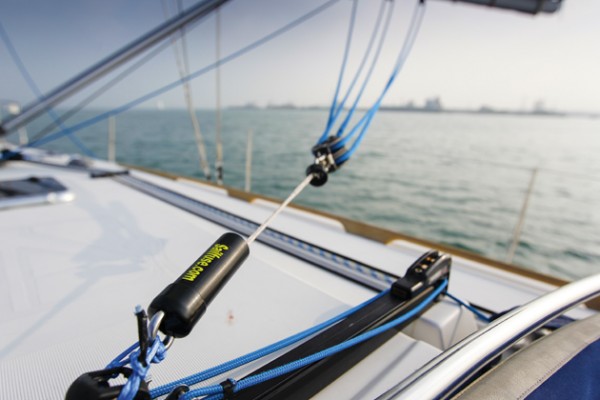Pip Hare tested the Sailfuse rig protector alongside two boom brakes and a traditional rope preventer for a comparison of boom brakes and preventers
Sailfuse tested
There are a number of solutions on the market to help control a gybe and minimise the effects of a crash gybe, but how practical, effective and relevant are they to the average cruising sailor?
With this in mind I borrowed a Dufour 385 and set out to test the Walder boom brake, the Wichard Gyb’Easy and the Sailfuse and compare them against a conventional gybe preventer set up with a long piece of line.
See here for the full comparative test
The day we chose to test these products I had doubts as to how much I would learn as there was very little wind and no chance for them to strain against the force of a fully loaded gybe. However, the benign conditions actually gave me a chance to get to grips with how each of them worked and assess how useful they would be in the everyday routine of a cruising sailor.
Fit and forget
The first thing I considered was how easy each product was to fit and whether they could be permanently rigged or would have to be fished out of a locker every time they were required. There is often a reality gap between what we know we should do and what we actually do where effort is involved.
The Sailfuse took a little time to set up properly, but once installed it can be left up permanently, being designed to be a fit-and-forget item. It has a different purpose from the other products; as the name suggests it is a ‘fuse’, the last resort should it all go horribly wrong and could be used in addition to the other products or as a standalone. It will not stop your boom from gybing.
Each Sailfuse is made to be boat-specific; the manufacturer uses the boat’s size, type and sail area to calculate the size of load that would potentially damage the rig and the fuse is created to break just before this load is experienced, absorbing the initial shock and avoiding damage to the rig.
I was not able to test out this theory in anger, but instead had a couple of ‘lightly rigged’ Sailfuses that would break under an easy load so I could see the system in action.
When put under a shock load the pin connecting the two ends of the fuse broke, allowing the body to extend out to the length of a Dyneema strop contained inside. I understood the theory and it seemed that this product could prevent damage to the traveller system if nothing else.
One consideration anyone using Sailfuse should have is the trim of the mainsheet. The Sailfuse will only work if it does come under load during the gybe. If the mainsheet is so far out most of the mainsail is resting against the shrouds, particularly on a boat with swept-back spreaders, it seems the force of the mainsail refilling may well be taken by the mast before the mainsheet has reached its full extent and the fuse bursts.
How to fit
- Fit the Sailfuse between the bottom mainsheet block and the traveller car.
- This may take a bit of thought, together with the right shackles. This did not prove simple on our test boat so we had to lash the Sailfuse in place.
Verdict
The most common cause of mast failure is down to a failure of the standing rigging caused by damage, overload or fatigue. Overload could be caused by a crash gybe in extreme conditions; however the more likely scenario would be repeated uncontrolled gybes over time leading to fatigue of the standing rigging or components. A fit-and-forget item such as the Sailfuse could well be useful in preventing damage in the first place




